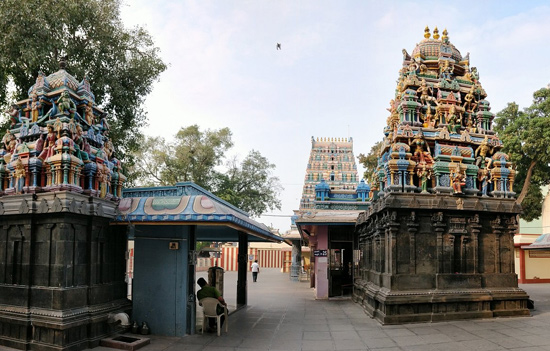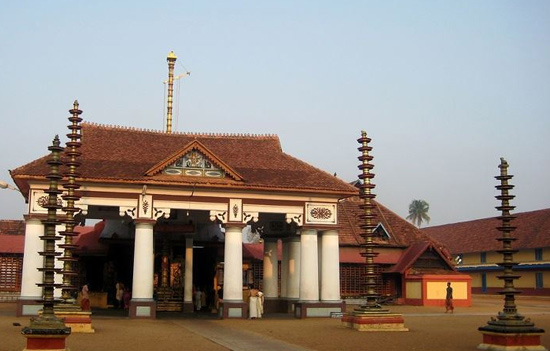- Know about three famous and revered
temples of Coimbatore. There is more to the city than textiles, foundries and
education.
When one thinks of Coimbatore, the image
that comes to mind is that of a bustling industrialised city. Also known as the
Manchester of India and the third-largest city in Tamil Nadu, Coimbatore is the
textile capital of South India. Its rich black soil contributed to its
flourishing agriculture sector, particularly the growth of cotton, which made
it the textile hub of South India. It is also famous for its foundries and
automobile industries, the manufacturing of textile industry equipment, spares,
motor pump sets, wet grinders and other engineering goods and services.
Interestingly, it is also an educational hub, with many engineering and medical
colleges.
One would, therefore, never think of
Coimbatore as a temple town. That claim to fame in Tamil Nadu goes to other
cities like Thanjavur and Madurai. Coimbatore ostensibly has only the
Marudhamalai Subramanya Swami Temple to boast of by way of famous temples.
Surprisingly, this textile city also has
some very ancient and beautiful temples in and around its vicinity, with
various interesting legends associated with them.
This article was first published in the Bhavan’s Journal.
 Patteeshwarar Temple.
Patteeshwarar Temple.
The most prominent of these temples is,
of course, the Patteeshwarar Temple at Perur. Situated 6 kms to the south-west
of Coimbatore town, on the southern banks of the Noyyal river, the ambience and
architectural style of the temple reminds one of the Brihadeshwara Temple at
Thanjavur.
Like the Periya Kovil at Thanjavur, the
Patteeshwarar Temple has also been built by a Chola king and therefore has a
distinct Dravidian flavour, similar to the Big temple. Dedicated to Lord Shiva,
it is believed to have been built by Karikala Cholan in the 2nd century C.E.
The deity is believed to be a swayambhu
lingam (self[1]emerged).
Legend has it that Kamadhenu worshipped Lord Shiva at this place for many years. Kamadhenu’s calf, known as Pattu, unknowingly stamped the Shiva lingam which was covered with mud and it was not able to pull out its leg. So, Kamadhenu tried to clear the mud with its horns and blood started oozing out from the place. Kamadhenu was terrified and Shiva revealed himself on this spot. The marks of the horns of Kamadhenu can be seen, as also the hooves of the calf on the lingam. The place is, therefore, also known as ‘Kamadhenupuram’ and Lord Shiva is known as ‘Patteeshwarar’.
The sanctum sanctorum of Lord
Patteeshwarar faces east and behind the main deity, one can find the divine cow
Kamadhenu with her calf Pattu. Behind the moolavar are the saptha linga and
sahasra linga (thousand lingas carved on a single linga). The other
peculiarities of the temple are that Bhairavar is without his vahana (creature
that serves as a vehicle) and is known as Gnana
Bhairavar.
Both Vishnu
Durgai and Shiva Durgai are present, which is, again, rare. The idol of
Hanuman here is four and a half feet tall and made of a single wood known asetti maram. Subramanyam Swami is in
Dandayudhapani form (one who bears the dandayudham, or spear) and this is one
of the only three places where the sanctum sanctorum of Lord Muruga is facing
the west, the other two being in Palani and Thiruvannamalai.
Right from the huge gates of the temple to the sanctum sanctorum, the temple’s antiquity is obvious in the oil-stained walls and ceilings. The spotlight of the temple is, of course, the Kanaka Sabha—the dance hall of Lord Nataraja. The Kanaka Sabha has the idols of Nataraja and Sivakami Ammal. Its lovely frescoes and sculpted images, similar to the ones at Madurai’s Meenakshi Amman Temple, take one back to the days when the Kanaka Sabha was a space where famous dancers would have showcased their art. The Nataraja idol of this temple is the most significant after the one at Chidambaram, and the place is also called Western Chidambaram (melai Chidambaram) in the ancient scriptures.
There are eight
magnificent moorthis on the pillars—that of Urthuva thandavam, Bitchadana moorthy, Gajasamhara moorthy, Agora Veerabhadhrar, Agni Veerabhadhrar moorthy, Alangattu Kali Amman, Nrithya Ganapathy and Subramanya Swami. It is said that the Nataraja and Sivakami Ammal sculptures were made by Kamaban Achari over a period of 28 years. There are 36
pillars. The pillars that surround the idols of Lord Nataraja and Sivakami Ammal are inclined as if to indicate humility. The carving of Lord Nataraja’s hair settling down indicates his calm posture after dance.
Other interesting facts about this temple are that it is also called ‘Dakshina
Kailasam’ and it is believed that one can attain mukti (spiritual liberation) by worshipping the deity of this place. There is a tamarind tree in front of the temple, near the temple tank, known as Pirava puli (the unborn tamarind), meaning that its seeds will not
germinate anywhere. It is supposed to symbolise the fact that the people who
worship here will attain salvation and be freed from the cycle of birth and
death. There is a palm tree called the Irava Panai (deathless palm), meaning
that those devoted to Lord Patteeshwarar would always be standing tall,
attaining name and fame. People are not allowed to take photographs or videos here
and there is always someone, either an attendant or a worshipper, who is
watchful and ready to admonish anyone who tries to break the rule.
 Koniamman Temple.
Koniamman Temple.
The Koniamman Temple is another ancient
temple in Coimbatore. The deity here is Parvathi and she
is considered the guardian deity of Coimbatore.
According to a legend, long ago, an Irula chieftan named Kovan worshipped Koyamma, later called ‘Konniamman’, and installed a simple stone statue. The present temple was later built during the 11th century by one of his descendants. It is believed that the word ‘Koyamputhur’ (another name of Coimbatore) comes from the goddess’ name, Konniamman. The antiquity of this temple
is also very evident in the oil-stained walls and the architecture of the
temple, which is Dravidian in style. The next destination is the Eachanari
Vinayagar Temple, which is also a very ancient temple.
 Vinayanagar Temple.
Vinayanagar Temple.
The story goes that when the vigraham
(idol) of Lord Vinayagar was being moved from Madurai to Perur, the axil of the
bullock cart carrying the vigraham broke. By the time it was repaired, the idol
could not be moved and was established here at the place called Eachanari, on
the Pollachi-Coimbatore road. The atmosphere at the temple is such that one can
visualise the bullock cart with its broken axil, the driver desperately trying
to set it right and Vinayagar waiting to be transported. The Kamakshi Amman
Temple is another must-visit at Coimbatore. Though it has no claim to antiquity
as some of the other temples, it has its own special type of sacredness. The
idol of Kamakshi Amman was installed with the blessings of Mahaperiyava i.e.
Chandrashekara Saraswati of Kanchi Kamakoti peetham, Kanchipuram.
Visiting these temples makes one realise that India’s rich cultural heritage is not confined to only a few famous places. It has struck deep roots in almost every town in the country, epitomising the local culture and architectural traditions.
 Shree Ayappan Temple.
Shree Ayappan Temple.
This article was first published in the Bhavan’s Journal, 28 February 2023 issue. This article is courtesy and copyright Bhavan’s Journal, Bharatiya Vidya Bhavan, Mumbai-400007. eSamskriti has obtained permission from Bhavan’s Journal to share. Do subscribe to the Bhavan’s Journal – it is very good.
Also
see album of
1. Brihadisvara
Temple, Tanjore
2.
Meenakshi
Temple, Madurai
3. Temples
of Kumbakonam
4.
Shiv Temples
across India